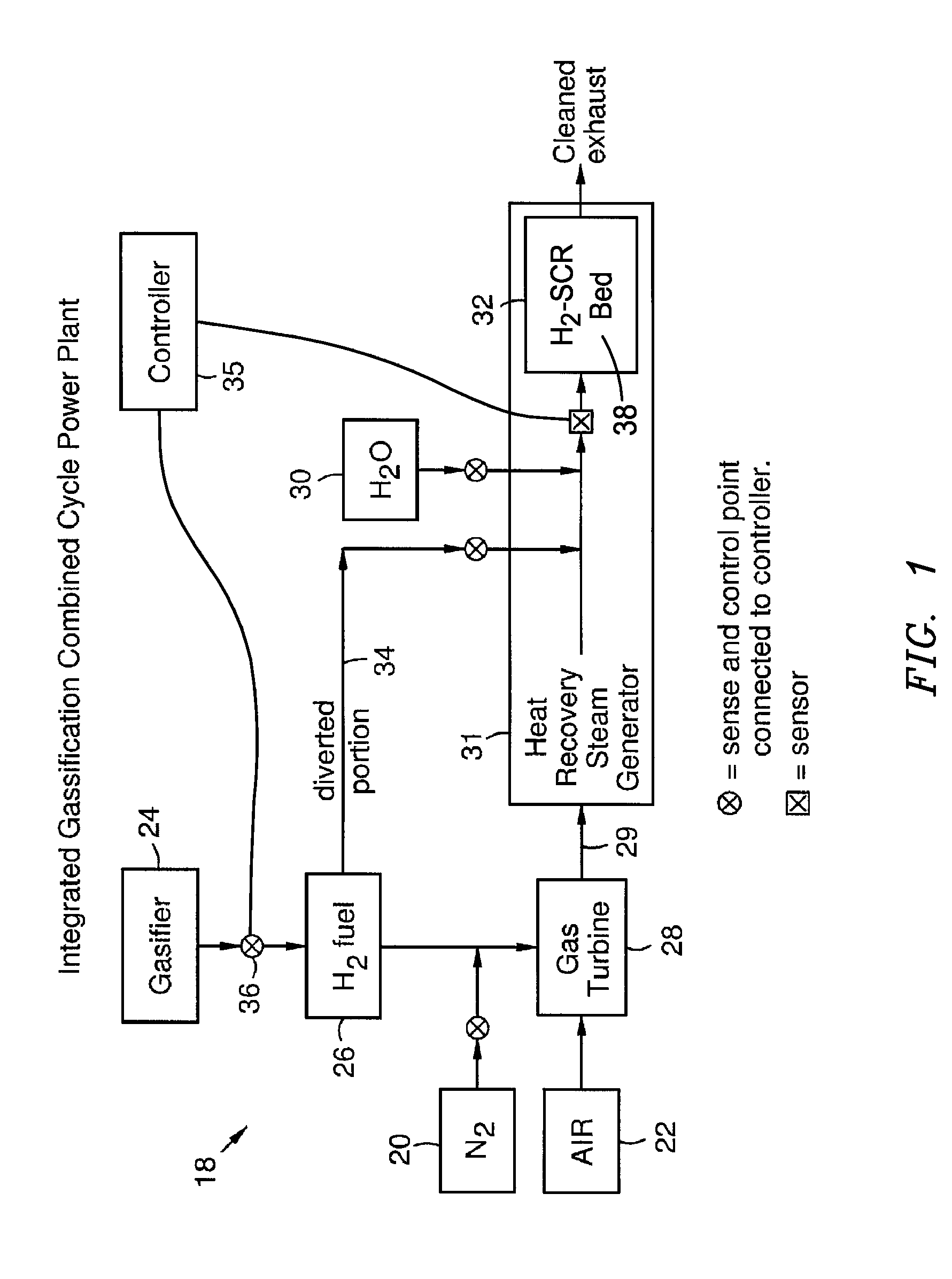Selective catalytic reduction system and process for treating NOx emissions using a palladium and rhodium or ruthenium catalyst
- Summary
- Abstract
- Description
- Claims
- Application Information
AI Technical Summary
Benefits of technology
Problems solved by technology
Method used
Image
Examples
example 1
[0036]This example illustrates a method of synthesis of a Pd-based catalyst supported with pre-sulfated zirconia binder on ZrO2—SiO2 washcoat particles to form a Pd / W / (ZrO2—SiO2)SO4 catalyst system with approximately 0.75-1.0 wt. % Pd. To arrive at this catalyst system, 4.5 kg of zirconium hydroxide were added to a 5 gallon pail with 4.5 L of deionized (DI) water and 750 g of a colloidal silica solution (40% SiO2). The pH of the zirconium hydroxide / silica solution was adjusted to about 3.0 with sulfuric acid and mixed overnight. The following morning, the solution was emptied into a pan and placed in an oven to dry at 110° C. to evaporate excess water. Once dried, the resulting zirconia-silica-sulfate material was crushed below 40-mesh and calcined at 650° C. for 2 hrs.
[0037]The washcoat with binder was prepared by adding 21 g of the zirconia-silica-sulfate material, 21 g of a zirconium oxynitrate solution (20% ZrO2), 0.266 g ammonium metatungstate (Aldrich,) and 50 mL of DI water t...
example 2
[0039]This example illustrates a method of synthesis of a Pd / Rh-based catalyst supported with pre-sulfated zirconia binder on ZrO2—SiO2 to form a Pd / Rh / W / (ZrO2—SiO2)SO4 catalyst system with approximately 0.75-1.0 wt % Pd and 0.0075-0.11 wt % Rh. To arrive at this catalyst system, 4.5 kg of zirconium hydroxide was added to a 5 gallon pail with 4.5 L of DI water and 750 g of a colloidal silica solution (40% SiO2). The pH of the zirconium silica solution was adjusted to 3.0 with sulfuric acid (Aldrich) and mixed overnight. The following morning, the solution was emptied into a pan and placed in an oven to dry at 110° C. Once dried, the resulting zirconia-silica-sulfate material was crushed below 40-mesh and calcined at 650° C. for 2 hrs.
[0040]The washcoat was prepared by adding 25 g of the zirconium-silica-sulfate material, 25 g of a zirconium oxynitrate solution (20% ZrO2), 1.667 g ammonium metatungstate (Aldrich) and 50 mL of DI water to a beaker. Monolith cores (300 cpsi) were dippe...
example 3
[0042]This example illustrates a method of synthesis of a Pd-based catalyst supported with pre-sulfated zirconia binder on ZrO2—SiO2 to form a Pd / Ru / W / (ZrO2—SiO2)SO4 catalyst system with approximately 0.75-1.0 wt. % Pd and 0.0075-0.11 wt. % Ru. To arrive at this catalyst system, 4.5 kg of zirconium hydroxide was added to a 5 gallon pail with 4.5 L of DI water and 750 g of a colloidal silica solution (40% SiO2). The pH of the zirconium silica solution was adjusted to 3.0 with sulfuric acid (Aldrich) and mixed overnight. The following morning, the solution was emptied into a pan and placed in an oven to dry at 110° C. to evaporate excess water. Once dried, the resulting zirconia-silica-sulfate material was crushed below 40-mesh and calcined at 650° C. for 2 hrs.
[0043]The washcoat was prepared by adding 25 g of the zirconium-silica-sulfate material, 25 g of a zirconium oxynitrate solution (20% ZrO2), 1.667 g ammonium metatungstate (Aldrich), and 50 mL of DI water to a beaker. The monol...
PUM
| Property | Measurement | Unit |
|---|---|---|
| mass ratio | aaaaa | aaaaa |
| mass ratio | aaaaa | aaaaa |
| mass ratio | aaaaa | aaaaa |
Abstract
Description
Claims
Application Information
 Login to View More
Login to View More - R&D
- Intellectual Property
- Life Sciences
- Materials
- Tech Scout
- Unparalleled Data Quality
- Higher Quality Content
- 60% Fewer Hallucinations
Browse by: Latest US Patents, China's latest patents, Technical Efficacy Thesaurus, Application Domain, Technology Topic, Popular Technical Reports.
© 2025 PatSnap. All rights reserved.Legal|Privacy policy|Modern Slavery Act Transparency Statement|Sitemap|About US| Contact US: help@patsnap.com



